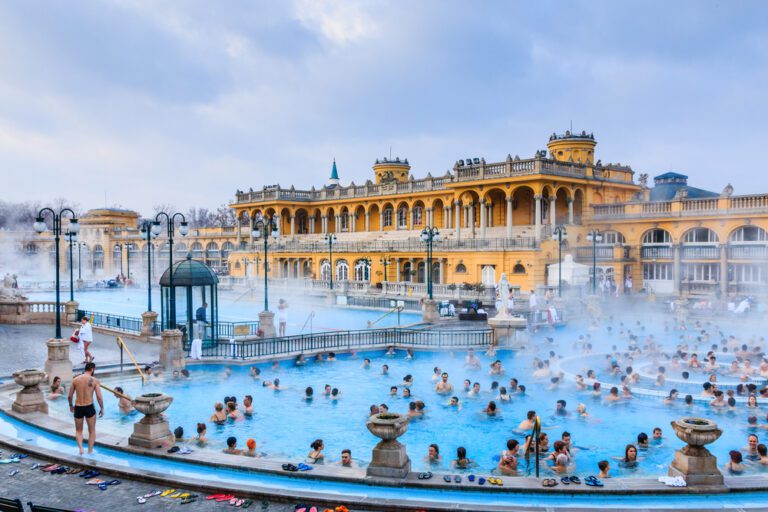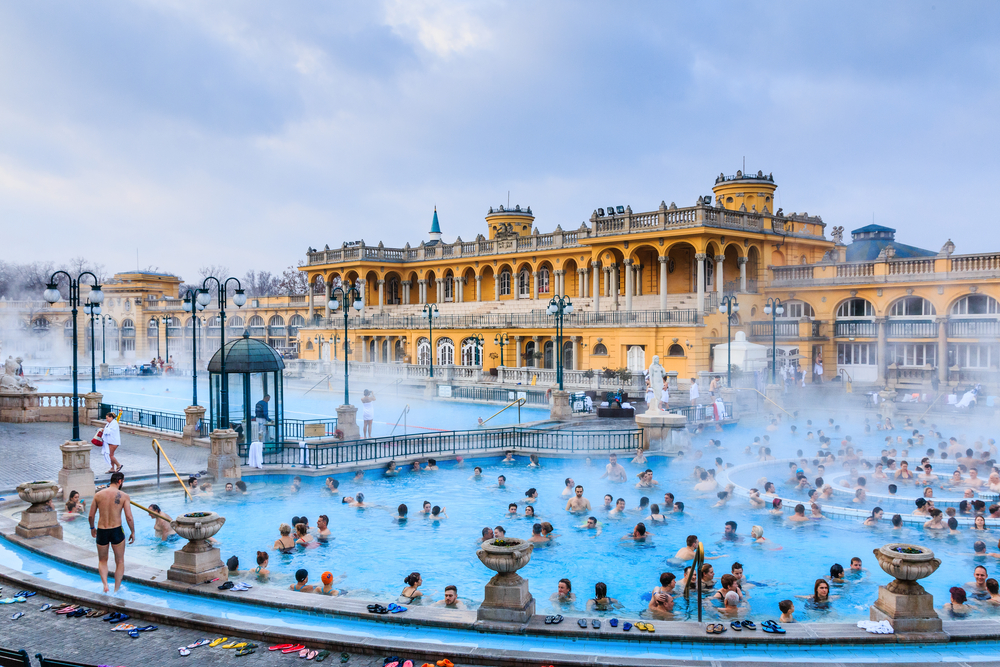
[ad_1]

For the stressed and overworked, there might be nothing more relaxing than a spa. Beyond the cucumber slices and hot towels, these leisurely destinations carry a fascinating legacy that extends back to ancient times. Bathing in mineral springs — a feature of many historic spas — has been considered a medical and therapeutic treatment throughout the ages, spawning the proverbial phrase “taking the waters”. Today, this practice is known as balneotherapy.
Some cities have made the most of mineral springs, building reputations as illustrious centers for spas. Though spas are often viewed as recreational spots and nothing more, their various incarnations around the world have developed significant cultural roles, thriving as staples of history and health tourism.
The Healing History of Baths
In antiquity, the link between bathing and health usually carried a religious undercurrent. Egyptians submerged themselves in the Nile River, Israelites in the Jordan River, and Hindus in the Ganges River; all of these waters have a sacred history as places of spiritual healing.
Baths continued to have religious and therapeutic meaning in ancient Greece, where the concept of health was first tied to the deity Apollo because he represented the Sun, which was believed to have healing power. Apollo’s divine progeny inherited this bond with health. His son, Asclepius, became known as a god of medicine, and among Asclepius’ offspring was Hygeia, a goddess of health who gave rise to the word “hygiene”.
Archaeologists found the fragments of six sculptures representing Asclepius and his family at the Great Baths of Dion, part of a complex that was home to thermal baths in the 2nd and 3rd centuries C.E. before an earthquake destroyed them.
The thermal baths of Dion featured a heating system called a hypocaust, which produced and circulated hot air below the floor. Hypocausts would later be used in Roman baths as well. (Credit: Shujaa_777/Shutterstock)
Asclepius also inspired the creation of temples used for worship and healing, known as Asclepieia. Water was likely a key feature of Asclepieia, since the temples were often built near sources of water such as natural springs and aquifers.
Read More: A History of Bathing: It Hasn’t Always Been About Hygiene
The First Spa Resorts: The Roman Thermae
Following in the footsteps of their Greek neighbors, Romans made bathing a fundamental activity in daily life. However, it seemed to include a stronger emphasis on socialization and leisure, akin to today’s spas.
Public baths took the form of thermae, large and luxurious complexes, and balneae, smaller and simpler spaces that were scattered throughout Roman neighborhoods.
Thermae embodied the imperial essence of the Roman Empire, grand in scale and embellished with stucco reliefs and mosaics. Surrounded by other amenities like libraries, shops, and lecture halls, they acted as a sort of proto-resort.
The elements of health and wellbeing were still promoted at thermae, which followed a structured process that moved visitors through multiple chambers.
Visitors would often enter and undress in the apodyterium (think a changing or locker room). They would then be anointed with oil and may have exercised immediately afterward in a court area. The three main bathing chambers, used in varying order, were the tepidarium (a warm room), the caldarium (a hot room), and the frigidarium (a cold room, often including a swimming pool). There were also two types of steam rooms, the laconicum (a dry heat room) and the sudatorium (a wet heat room with more steam).
As the Roman Empire expanded across Europe, so did thermae. Remnants of these facilities have been left in Italy and other countries, such as France, the United Kingdom, and Turkey. Perhaps the most famous of all Roman baths lies in the aptly-named city of Bath, England, where Romans constructed a thermae near a natural spring around 70 C.E., early on in the Roman occupation of Britain. Having been updated in modern times, the Roman Baths make for an iconic tourist destination.
The Roman Baths in Bath, England attract over a million visitors every year. Though visitors aren’t allowed to bathe in the waters, they can tour the baths and a museum with Roman artifacts. (Credit: Boris Stroujko/Shutterstock)
Thermae toppled along with the Roman Empire, but their spirit lived on through the Hammam, or Turkish Bath, in the Islamic world. These facilities adopted the thermae style of communal bathing, with multiple rooms to move through, while adding distinct aspects of Islamic tradition.
The Rise of Spa Towns
The natural springs once cherished by the Greeks and Romans were still visited despite thermae falling into disrepair. Public bathing ebbed during Medieval times due to bathhouses being associated with sex and the spread of syphilis, but spas eventually rose in popularity.
The word “spa” actually comes from the Belgian city of Spa. Starting in the 16th century, the city’s natural springs captured the attention of many who came to believe the water possessed healing powers.
As spas grew, monarchs and aristocrats desired to “take the waters”. Later, the wealthy bourgeoisie followed the trend in the 19th century, finally breathing life back into the social appeal of spas and making them fashionable.
By the turn of the 20th century, spas had become massive resorts enjoyed by middle-class visitors who arrived in crowds via train. Around World War II, however, people started to leave them behind for revolutionary innovations in entertainment, technology, and medicine.
Despite this downward trend, the spa and thermal/mineral spring industries have survived into the 21st century and have even seen a renewed wave of revitalization. In 2021, UNESCO officially categorized 11 European cities as the Great Spa Towns of Europe, now a transnational World Heritage Site.
Karlovy Vary, a city in the Czech Republic, is one of the 11 Great Spa Towns of Europe. Credit: (Jiri Vanicek/Shutterstock)
Other cultures outside of Europe enjoy quality spa time as well. In particular, Japan is famous for its picturesque “onsen”, hot springs and the bathing facilities and inns around them.
The U.S. also caught spa fever during the late 19th and early 20th centuries, though American spa towns don’t quite boast the same renown as European ones. A well-known example of an American spa town is Hot Springs, Arkansas, known for Bathhouse Row. Although most of the bathhouses here do not operate as traditional bathing facilities anymore, there are still some opportunities for visitors to soak in warm water and unwind.
Read More: Aqueducts: How Ancient Rome Brought Water to Its People
Do Natural Springs Have Health Benefits?
After all this talk about spas and springs, you may be wondering: does “taking the waters” really improve your health?
In a few ways, it appears so, but don’t expect mineral water to be a cure-all for any affliction, as proposed by the affluent spa patrons of old who tended to latch onto pseudoscience.
Balneotherapy has been shown to impart certain physical and mental benefits, particularly for those with musculoskeletal diseases. A 2021 study found that balneotherapy seemed to improve the quality of life of patients with rheumatoid arthritis.
Studies have suggested that balneotherapy can improve cardiovascular function and reduce hypertension since being exposed to a hot spring bath lowers blood pressure and reduces stiffness of the arteries. However, for those with more serious heart-related issues, it is recommended to talk with a doctor before going to a hot spring. Sudden or prolonged immersion in hot water can elevate heart rate, causing cardiovascular stress depending on one’s condition. Also crucial to remember is that sitting in a hot spring for too long can lead to hyperthermia (overheating of the body) and heat stroke.
Balneotherapy may boost skin health and improve inflammation, and it has been used to treat certain conditions like psoriasis and atopic dermatitis. This is largely due to the mineral composition of spring water, which contains varying amounts of sulfur, manganese, magnesium, zinc, selenium, strontium, silica, and calcium bicarbonate.
Along with the physical benefits, soaking in a spa may also lower stress and improve mental health, as shown in a 2023 Japanese study.
While the healing properties of mineral springs, once hailed as a magic solution for any ailment, have been overstated in centuries past, it seems that some benefits potentially exist. So if you’re in need of a pick-me-up, treat yourself to a spa day and give your mind and body the relaxation they need.
Read More: Why Are Humans So Drawn to Water?
Article Sources:
Our writers at Discovermagazine.com use peer-reviewed studies and high-quality sources for our articles, and our editors review them for accuracy and trustworthiness. Review the sources used below for this article:
Open Access Macedonian Journal of Medical Sciences. History of the Baths and Thermal Medicine
Britannica. Thermae
Britannica. Roman Baths
International Journal of Emerging Technologies and Innovative Research. Bathing in History: A Comprehensive Study of the Ḥammām (Bathhouse) at Qutb Shahi Heritage Park, Hyderabad
JSTOR. Scrub-a-Dub in a Medieval Tub
European Historic Thermal Towns Association. Spa Towns as Places for History
Great Spa Towns of Europe. Welcome to the Great Spa Towns of Europe
National Park Service. Bathhouse Row
International journal of environmental research and public health. Therapeutic Benefits of Balneotherapy on Quality of Life of Patients with Rheumatoid Arthritis: A Systematic Review
Hypertens Res. Cardiovascular physiological effects of balneotherapy: focused on seasonal differences
Journal of clinical medicine. The Role of Thermal Water in Chronic Skin Diseases Management: A Review of the Literature
Heliyon. Hot spring bathing practices have a positive effect on mental health in Japan
[ad_2]